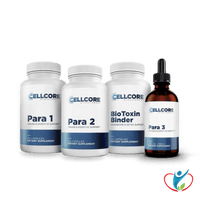Purpose
There are eight types of vitamin B. The six varieties of vitamin B listed below are the most important to maintain optimal health. Each plays several roles to maintain body function..
|
B1 (Thiamin)
|
B2 (Riboflavin)
|
B3 (Niacin)
|
B6 (Pyridoxine)
|
B9 (Folate) |
B12 (cyanocobalamin)
|
|
-Breaking down sugar (carbohydrate) molecules from food -Creating certain neurotransmitters (brain chemicals) -Producing fatty acids -Synthesizing certain hormones
|
-Energy production -Helping the body break down fats, drugs, and steroid hormones -Converting tryptophan into niacin (vitamin B-3) -Converting vitamin B-6 into a coenzyme that the body needs
|
-Changing the energy in carbohydrates, fats, and proteins into a form the body can use -Metabolic processes in the body’s cells -Communication among cells -Expression of DNA in cells
|
-Amino acid metabolism -Breaking down carbohydrates and fats -Brain development-immune function
|
-DNA replication -Metabolism of vitamins -Metabolism of amino acids -Proper cell division
|
-Creating new red blood cells -DNA synthesis -Brain and neurological function -Fat and protein metabolism
|
Recommended Daily Intake
Vitamin B is a water-soluble vitamin so unlike fat-soluble vitamins, it is generally less likely to develop vitamin B toxicity from taking too much of it. Most often, our systems simply flush out excess amounts of vitamin B in our urine. There are, however, side effects to over-consuming Vitamin B, specifically B3 and B6.
B3 overdose side effects:
- Vomiting
- High blood sugar levels
- Skin flushing
- Liver damage
B6 overdose side effects:
- Nerve damage
- Light sensitivity
- Painful skin lesions
|
|
B1 (Thiamin)
|
B2 (Riboflavin)
|
B3 (Niacin)
|
B6 (Pyridoxine)
|
B9 (Folate) |
B12 (cyanocobalamin)
|
|
Birth to 6 months |
0.2 mg | 0.3 mg |
2 mg |
0.1 mg |
65 mcg DFE** |
0.4 mcg |
| Infants 7–12 months | 0.3 mg | 0.4 mg | 4 mg NE* | 0.3 mg | 80 mcg DFE | 0.5 mcg |
| Children 1–3 years | 0.5 mg | 0.5 mg | 6 mg NE | 0.5 mg | 150 mcg DFE | 0.9 mcg |
| Children 4–8 years | 0.6 mg | 0.6 mg | 8 mg NE | 0.6 mg | 200 mcg DFE | 1.2 mcg |
| Children 9–13 years | 0.9 mg | 0.9 mg | 12 mg NE | 1.0 mg | 300 mcg DFE | 1.8 mcg |
| Teen males 14–18 years | 1.2 mg | 1.3 mg | 16 mg NE | 1.3 mg | 400 mcg DFE | 2.4 mcg |
| Teen females 14–18 years | 1.0 mg | 1.0 mg | 14 mg NE | 1.2 mg | 400 mcg DFE | 2.4 mcg |
| Adult males | 1.2 mg | 1.3 mg | 16 mg NE | 1.3-1.7 mg | 400 mcg DFE | 2.4 mcg |
| Adult females | 1.1 mg | 1.1 mg | 14 mg NE | 1.3- 1.5 mg | 400 mcg DFE | 2.4 mcg |
| Pregnant teens and females | 1.4 mg | 1.4 mg | 18 mg NE | 1.9 mg | 600 mcg DFE | 2.6 mcg |
| Breastfeeding teens and females | 1.4 mg | 1.6 mg | 17 mg NE | 2.0 mg | 500 mcg DFE | 2.8 mcg |
*"The mg NE measure is used because your body can also make niacin from tryptophan, an amino acid in proteins. For example, when you eat turkey, which is high in tryptophan, some of this amino acid is converted to niacin in your liver. Using mg NE accounts for both the niacin you consume and the niacin your body makes from tryptophan. Infants in their first six months do not make much niacin from tryptophan." (https://ods.od.nih.gov/factsheets/Niacin-Consumer/)*
**"The measure of mcg DFE is used because your body absorbs more folic acid from fortified foods and dietary supplements than folate found naturally in foods. Compared to folate found naturally in foods, you actually need less folic acid to get recommended amounts. For example, 240 mcg of folic acid and 400 mcg of folate are both equal to 400 mcg DFE."(https://ods.od.nih.gov/factsheets/Folate-Consumer/)**
Signs and Symptoms of Deficiency
|
B1 |
B2
|
B3
|
B6
|
B9 |
B12
|
|
-Confusion -Cracks around mouth
|
-Confusion -Cracks around mouth
|
-Digestive issues -Confusion -Pellagra
-Fatigue -Aggressive, paranoid, or suicidal behavior -Hallucinations
|
-Anemia -Depression -Confusion -Nausea -Susceptibility to infections -Skin rashes or dermatitis -Skin disorders
|
-Fatigue -Trouble concentrating -Irritability -Headache -Heart palpitations -Shortness of breath -Open sores in the mouth -Changes in skin, hair, or fingernail color -Neural tube defects in fetal development |
-Tiredness or fatigue -Weakness -Constipation -Loss of appetite -Weight loss -Numbness and tingling in the hands and feet -Balance problems -Confusion -Poor memory -Soreness of the mouth or tongue |
Food Sources
Optimal sources of vitamin B are grass-fed, pasture-raised, wild-caught, and organic varieties of food. It is important to eat these types of foods over heavily processed sources. Consuming these more natural states of foods ensures you are eating quality products without harmful chemicals or additives.
Sources of vitamin B1 include:
- Organic sprouted ancient whole grains
- Pasture-raised pork
- Wild-caught fish
- Organic legumes, black beans, and organic soybeans
- Organic sprouted nuts and seeds
- Organic fortified bread, cereal, pasta, and rice
Sources of vitamin B2 include:
- Pasture-raised eggs
- Pasture-raised organ meats (kidney and liver)
- Pasture-raised lean meats
- Grass-fed dairy products
- Organic green vegetables (broccoli and spinach)
- Organic fortified cereals, grains, and bread
Food sources of vitamin B3 include:
- Grass-fed, pasture-raised, and wild meats (poultry, beef, pork, and fish)
- Some nuts, legumes, and grains
- Fortified breads and cereals
Foods high in vitamin B6 include:
- Pasture-raised poultry, wild-caught fish, and pasture-raised organ meats
- Organic potatoes and starchy vegetables
- Fruits, except for citrus fruits
Food sources of B9 (folate) include:
- Grass-fed beef liver
- Asparagus
- Brussels sprouts
- Dark green leafy vegetables (spinach and mustard greens)
- Oranges and fresh-pressed orange juice
- Other fruits and fresh pressed fruit juices
- Almonds, sunflower seeds, and peanuts
- Beans (kidney beans)
- Organic peas (black-eyed peas)
Foods fortified with folic acid to AVOID:
- Enriched bread, flour, pasta, and rice
- Fortified breakfast cereals
- Corn tortillas and tamales made with fortified flour
Overconsumption of low-quality folic acid fortified products can overwhelm the process that coverts folic acid to its active form and leave unmetabolized folic acid (UMFA) in our bodies. Several studies provide evidence that chronically elevated levels of UMFA may have adverse health effects, including increased cancer risk.
The best sources of vitamin B12 include:
- Grass-fed beef liver
- Wild clams
- Wild-caught fish
- Pasture-raised poultry
- Pasture-raised eggs
- Grass-fed milk
- Raw grass-fed cheese
- Organic fortified breakfast cereals
- Organic nutritional yeast
- Other fortified foods, including organic plant milks and flours
Healthy Beings' Strategies to Address Deficiency
Healthy Beings offers supplements and services that can mitigate and address deficiencies you might be struggling with. We also offer recommendations beyond our current available inventory. You will find suggestions below that can help prevent a deficiency. If you are not sure if you have a deficiency, contact us HERE and we will answer questions you might have.
Maintain Optimal Vitamin B Levels!
- Basic B Complex
- B-Complex #6
- B-Complex #12
- Stress B-Complex
- Health Coach Appointment
- Physician Appointment
Sources
1. https://www.medicalnewstoday.com/articles/325292#vitamin-b-122. https://www.healthline.com/nutrition/vitamin-b-complex












